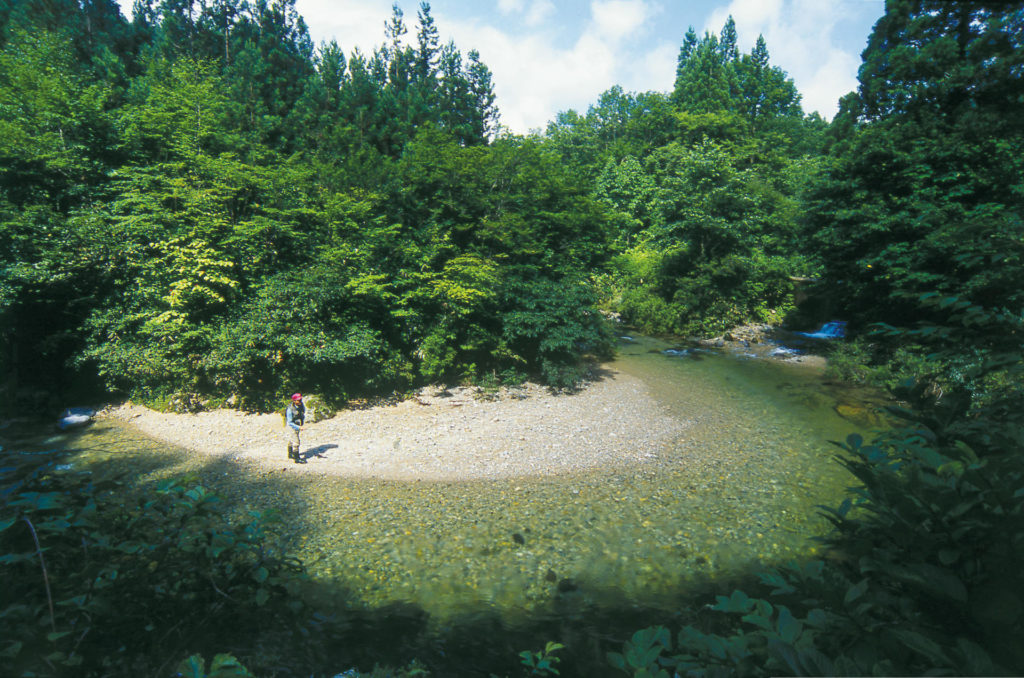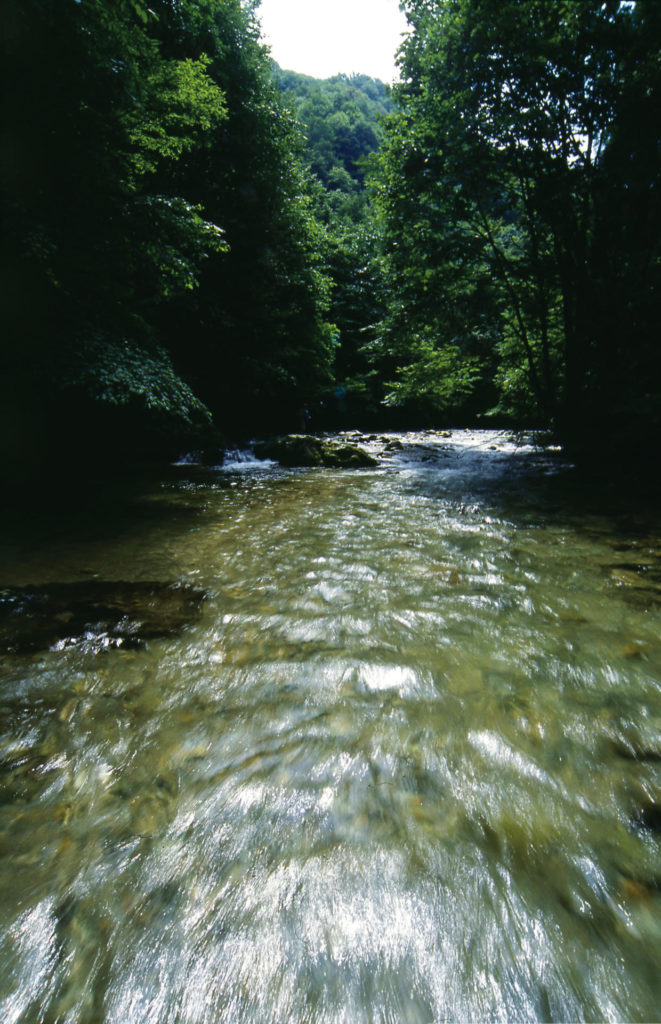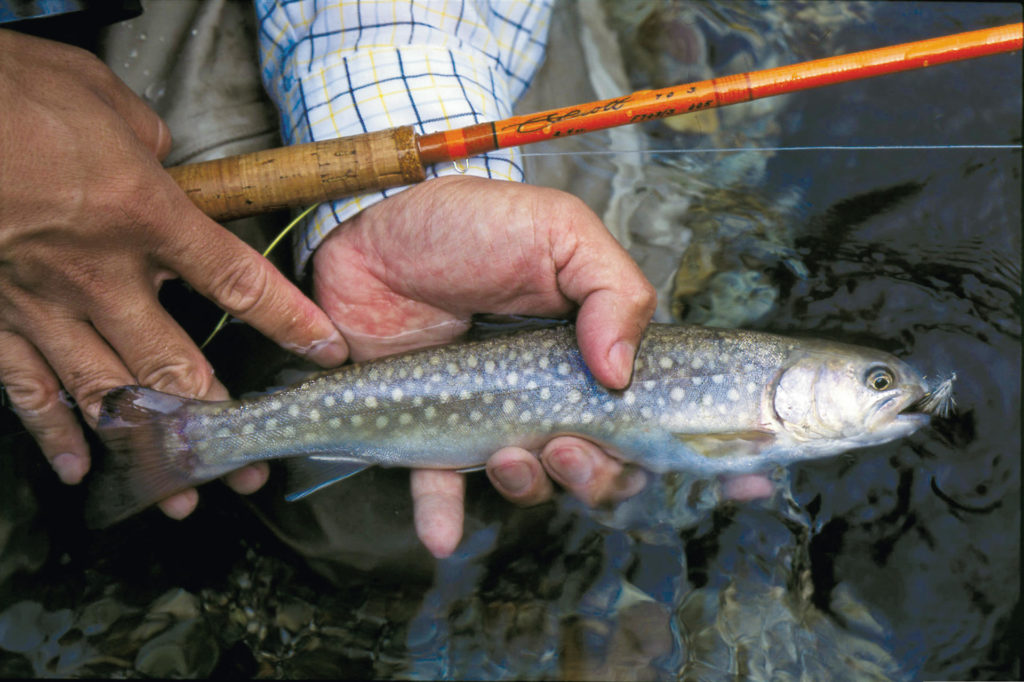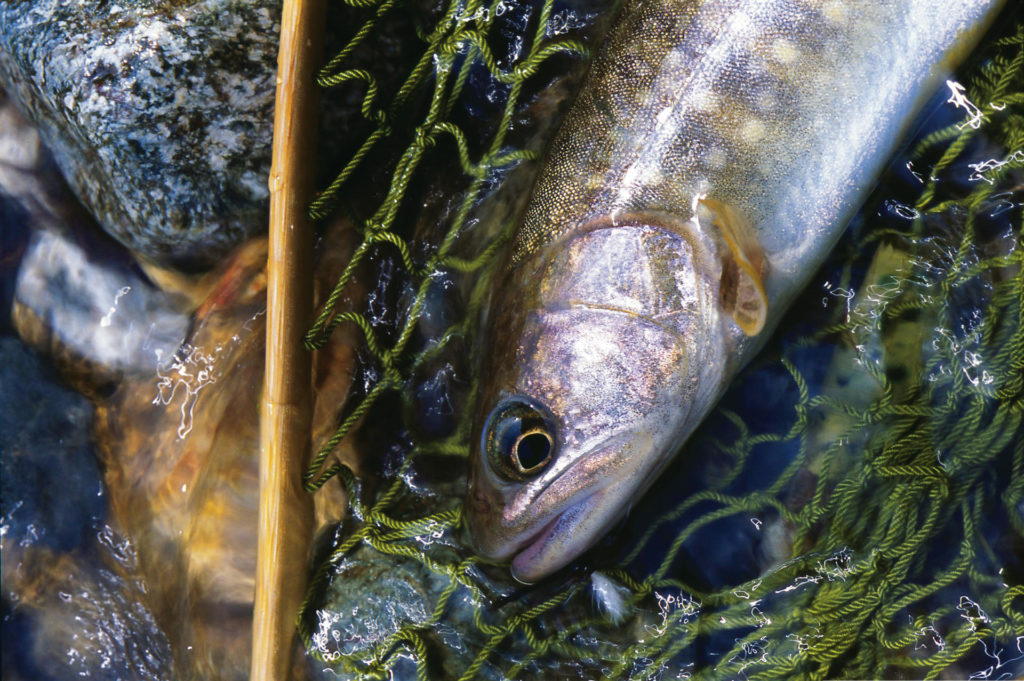The mountain trout are there, in Tohoku, thriving in the beautiful streams which flow through beech forests. For the next several days, I’ll trace my way through what resembles a miniature garden and back to the emerald green riverhead—a stream fisherman’s utopia.

I have fished my share of rivers over the years, but in the early summer I still find myself drawn to the rivers of Tohoku—particularly those in the northern regions of Akita and Iwate Prefectures. The arrival of summer always draws my thoughts to fishing to my heart’s content for mountain trout in the moss-covered river beds and enjoying drinks and conversation typical of when friends gather around an open fire.
Due to the large amount of snowfall last year, I heard summer would be two weeks slow in finding its way to the riverheads of northern Japan. As I prepare to leave behind the thatched roofs, which lie at the base of the headstream, I purchase some cigarettes and beer from a fair-skinned grandmother who 20 years ago would have turned heads with her bijin beauty.
Akita is famous in Japan for its bijin (beautiful women). The paved road soon turns to gravel, and I spot a small shrine in the forest to my right. I take the time to step out of the car and, placing my hands together, pay respects to the journey ahead.
Parking the car in an open area, I pack my fishing gear, change clothes and haul myself down to the river’s edge. My backpack is brimming with food and gear which I’ll be carrying for five kilometers on today’s hike.

With my rod in hand, I slowly trace my way along the river and gather tara sprouts, which grow from areas where the sunlight strikes the land. The meandering stream has neither rough swims nor steep gorges, providing a comfortable place to fish.
With the plastic bag of tara sprouts still hanging from my hip, I continue upstream, taking my rod out only at the most promising points, looking past second- and third-rate fishing spots. With a flick of the wrist an 18-cm., beautiful trout suddenly flies out from the water. My friend makes his way toward a mouth-watering spot under a fallen tree, but the fish makes a daring escape just before being netted.
It is now 3 in the afternoon, and we decide to set up camp in a flat area with trees along the right bank. After spreading out our mattresses on the bed of leaves and short-grass, we cut some fallen limbs for poles and stretch a tarp across them. Firewood is plentiful along the shore, and soon we have rice cooking in a pot full of streaming water. It hangs from a wire threaded around a stick, while the beer is kept cold immersed in the river in a vinyl sack.
As the sun sets, the fish begin to splash constantly and through polarized lenses I can see a group of mountain trout gathering in the shallows. My heart skips a beat as a 30-cm. fish flashes in front of me just below the surface. Another, slightly smaller, trout nibbles on my dry fly and soon after a large one takes the bait only to break the line and escape. My fishing pole draws a smooth arc across the water.
In a six-meter wide, 60-cm. deep portion of the river such as this, the fish will not be able to evade me. I create a small rock pool on the bank of the river and use it to hold the day’s catch. Not planning to eat fish tonight, I could simply release them back into the river; but for the moment they’ll be “mine” for me to occasionally reach down and touch them.

The hand-made pool soon turns into a fish farm and, just when I think I’ve taken every trout from the river, my friend makes his way back toward me. He casts in the area where I just wreaked havoc, and a puzzled look soon crosses his face. Feeling sorry for him, I quietly release my trout back into the river as the sun sets.
The campfire is ablaze and the boiled tara sprouts covered in soy sauce and mayonnaise go well with the drinks. The orchestra of insects is not yet at their full, mid-summer volume, but in tune with the shochu (rice liquor) they lull us into a deep sleep.
Even during the first of summer, a morning on the riverbanks of northern Tohoku is quite chilly. We begin the day slowly in time with the warm rays of sunshine. We cut dough made from flour and water into udon-sized noodles on a flat rock and spread them out on a plywood cutting board. After boiling the noodles and adding spices, our efforts are soon rewarded with a delicious meal. After breakfast we pack our gear, clean up the campsite and continue making our way upstream.
In midsummer we eat somen (cold noodles) flavored with ginger and onions. Fuki (mountain vegetables) grow wild here as well, and when cooked with soy sauce and peanut oil they go well with a drink. Any leftover fuki can be soaked in stream water overnight to remove some of the bitterness, and they are perfect in miso soup.

Any trout we decide to eat is cooked and eaten gratefully. Sometimes we remove the skin and eat it as sashimi (raw), while at other times a bit of wasabi (Japanese horseradish) is added and brought together with rice to make sushi. Gutting the fish and marinating it in miso for the day takes time, but is worth the wait when evening comes.
During our time on the river our thoughts turn simplistic. What’s for lunch? What would go well with the drinks tonight? Is an even bigger and more beautiful fish lying in wait around the next bend?
My trips to the riverheads of northern Tohoku are neither penance nor adventure. They simply provide the simple enjoyment of freedom in the northern streams.




